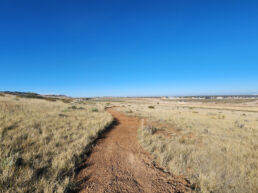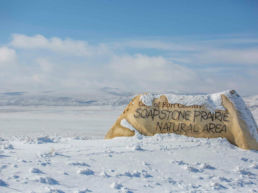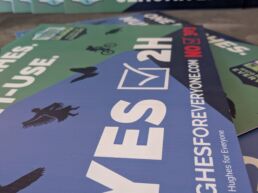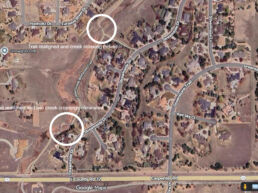Written by Sara Kammlade exclusively for YGR.
Short Version:
Use Tough Pads™ to treat road rash.
-
Order some here now so you have them; they’re hard to find in drugstores.
-
Clean the wound.
-
Apply overlapped as necessary, and leave on for an extended period of time.
-
Don’t use them on deep gashes or any wounds you can’t get clean.
We feel so strongly about this method that we’re donating some bandages to YGR’s Wounded Rider Project. We hope you don’t need to use them.
————————————————————————————————————————-
Long Version:
I crashed in the Rio Road Race last week and lost a lot of skin after hitting the pavement at 37mph. This was a first for me, but fortunately my husband Will knows a thing or two about bike racing and its side effects.
In 2007 Will crashed in a crit. On his way home he stopped at Safeway and bought one of every product marketed for abrasions. The superficial road rash down the outside of his left leg made for a perfect experiment site, pitting the different bandages against each other. Johnson & Johnson’s Tough Pads™ quickly emerged as the clear winner.
Tough Pads, a hydrocolloid dressing, are impermeable and adhere to the skin to create a warm, moist, hypoxic environment ideal for wound healing.1 The bandage contains gel-forming agents (colloids) which absorb wound exudate allowing the bandage to stay on for multiple days without disturbing the wound. Even better, the waterproof exterior and flexibility of the bandage allow you to bathe and move comfortably.
Since that day in 2007 Will has been a Tough Pad evangelist and last week I shotgunned the kool-aid and smashed the can on my forehead.
After my crash Will drove me home where we assessed my wounds, then cleaned and patched up my skin quickly blowing through our stash of 17 Tough Pads. We were unable to cover everything so supplemented with “nonstick” gauze. We found the following protocol worked well:
Step 1: Clean
Rinse wounds with mild soap and warm water. Gently scrub out any road debris and dried blood using a clean washcloth. Pat dry. Shave hair around wounds.
Step 2: Cover
Warm up the bandage between your hands. Apply bandages at least ½” beyond the edge of the wound. Overlap bandages in a patchwork manner to cover large wounds overlapping at least ¼”. Place hand over the bandage to keep it warm as you press it down firmly onto the skin paying close attention to the edges. Wounds will weep exudate while healing; allowing plenty of edge and overlap will reduce chances of leakage.
The Tough Pad directions say to make sure the wound is clear of any debris and ointments before applying the bandage. I put some triple antibiotic ointment on a few gashes and found it only slowed wound healing – presumably the ointment impeded wound debridement and absorption into the bandage.
Step 3: Enjoy
Leave the bandages on for several days (I’ve left some on as long as 8 days). As the wound weeps the bandages will absorb the fluid and puff up. As with all wounds monitor closely for signs of infection (swelling, redness, tenderness, etc). If infections occur seek medical care immediately. Note: the bandages develop a weird “cheesy” smell as they absorb exudate; this is normal.
If a bandage leaks apply another one overlapping the leaking edge. If necessary remove the bandage and replace it but the less the wound is disturbed the faster it will heal.
Step 4: Remove
After anywhere from 3-8 days you can remove the dressing revealing shiny new skin. This skin will be tender and particularly sensitive to sun so be sure to keep covered and use sunscreen when outside.
Step 5: Tell your friends
Restock your supply.
Tough Pads are no longer carried at Safeway and are difficult to find in stores. Below we have identified similar products and where to find them as well as instructions and photos about how we used them. The best deals are buying in bulk online, but we have found some products you can buy in person here in Fort Collins if you are in a bind.
|
Product |
Brand |
Size |
Buy in town |
Buy online |
Comments |
|
Tough Pads™ |
Johnson & Johnson |
2.8” x 2.4” |
n/a |
Tried and true. Stock up. |
|
|
Hydrocolloid Dressings |
ReliaMed |
4” x 4” |
n/a |
I didn’t try these until 7 days post-crash so cannot speak to their absorption. The edges of these bandages are beveled so I would suggest cutting the border edge off of the bottom bandage if you plan to overlap them to cover a large area. |
|
|
Blister Bandages |
Kroger |
1” x 2” |
King Soopers ($4/box of 6 bandages) |
n/a |
These thinner dressings have a smaller absorption capacity than Tough Pads or the Hydrocolloid Dressings and are best used for patching a leaking edge or for a round-2 dressing on a small wound. |
|
DuoDERM® Signal™ |
ConvaTec |
4” x 4” |
City Drug ($9/bandage) |
Less flexible than the Tough Pads, but effective. |
|
|
Exuderm® |
Medline |
4” x 4” |
PVHS Home Medical Supply ($12/bandage) |
Have not tried or seen in person. |
 These areas are covered in overlapping Tough Pads – 5 on the calf, 4 on the quad. Pads have been on for five days in this photo. Notice they are puffed up from absorbing wound exudate. We were conserving pads so missed the perimeters of the wounds. Ideally the quad would have 9 pads, the calf 8. The bandages leaked on the edges and have been patched with some blister bandages after supplementing with nonstick gauze on the first few days.
These areas are covered in overlapping Tough Pads – 5 on the calf, 4 on the quad. Pads have been on for five days in this photo. Notice they are puffed up from absorbing wound exudate. We were conserving pads so missed the perimeters of the wounds. Ideally the quad would have 9 pads, the calf 8. The bandages leaked on the edges and have been patched with some blister bandages after supplementing with nonstick gauze on the first few days.
 (Left) Arm wound after cleaning day of crash. This wound had one Tough Pad on it but could have used 2-3. (Center) We replaced the Tough Pad with a DuoDERM bandage after four days and took this photo one day later. (Right) New skin, twelve days after the crash.
(Left) Arm wound after cleaning day of crash. This wound had one Tough Pad on it but could have used 2-3. (Center) We replaced the Tough Pad with a DuoDERM bandage after four days and took this photo one day later. (Right) New skin, twelve days after the crash.
Here’s some more information about hydrocolloid dressings for you nerds:
In the early 60s several key studies demonstrated that wounds heal faster when kept wet than when kept dry and allowed to scab2,3 laying the groundwork for the “moist wound healing” school of thought. In the early 80s hydrocolloids were developedand incorporated into wound care4,5 as one of the first modern dressings. Following this a slurry of studies found occlusive hydrocolloid dressings healed wounds faster than gauze,6,7 were less painful,8 had lower instances of infection9,10 and were less expensive given less labor time for a nurse or caregiver.8
Many modern dressings are now utilized in wound management,1 but gauze is still commonly used11 inspiring one medical professional to refer it as “archaic and barbaric” in an academic journal.12 Having used nonstick gauze to supplement my Tough Pads I’d say the process felt nothing short of savage.
1 Boateng, J. S., Matthews, K. H., Stevens, H. N., & Eccleston, G. M. (2008). Wound Healing Dressings and Drug Delivery Systems: A Review. Journal of Pharmaceutical Sciences,97(8), 2892-2923. doi:10.1002/jps.21210
2 Winter, G. D. (1962). Formation of the Scab and the Rate of Epithelization of Superficial Wounds in the Skin of the Young Domestic Pig. Nature, 193(4812), 293–294. doi:10.1038/193293a0
3 Hinman, C. D., & Maibach, H. (1963). Effect of Air Exposure and Occlusion on Experimental Human Skin Wounds. Nature,200(4904), 377-378. doi:10.1038/200377a0
4 Volke, Robert W. (1988). Patent No. US4743499 A. Washington, DC: U.S. Patent and
Trademark Office.
5 Samuelson, Peter (1989). Patent No. US4867748 A. Washington, DC: U.S. Patent and
Trademark Office.
6 Singh, A., Halder, S., Chumber, S., Misra, M. C., Sharma, L. K., Srivastava, A., & Menon, G. R. (2004). Meta-analysis of Randomized Controlled Trials on Hydrocolloid Occlusive Dressing Versus Conventional Gauze Dressing in the Healing of Chronic Wounds. Asian Journal of Surgery,27(4), 326-332. doi:10.1016/s1015-9584(09)60061-0
7 Bouza C, Saz Z, Muñoz A, Amate JM. Efficacy of advanced dressings in the treatment of pressure ulcers: a systematic review. Journal of Wound Care. 2005:14(5):193-9.
8 Heyneman, A., Beele, H., Vanderwee, K., & Defloor, T. (2008). A systematic review of the use of hydrocolloids in the treatment of pressure ulcers. Journal of Clinical Nursing,17(9), 1164-1173. doi:10.1111/j.1365-2702.2007.02218.x
9 Hutchinson, J., & Mcguckin, M. (1990). Occlusive dressings: A microbiologic and clinical review. American Journal of Infection Control,18(4), 257-268. doi:10.1016/0196-6553(90)90167-q
10 Hutchinson, J., & Lawrence, J. (1991). Wound infection under occlusive dressings. Journal of Hospital Infection,17(2), 83-94. doi:10.1016/0195-6701(91)90172-5
11 Armstrong M.H., Price P. (2004). Wet-to-dry dressings: Fact and fiction. Wounds 16(4):56–62.
12 Fleck, C. A. (2009). Why ‘‘Wet to Dry’’? Journal of the American College of Certified Wound Specialists,1, 109-113. doi:10.1016/j.jcws.2009.09.003
